Ottimizzare le immagini prima di caricarle su WordPress migliora notevolmente la velocità del sito web. Eppure molti principianti hanno siti web lenti semplicemente perché caricano immagini non ottimizzate.
Noi di WPBeginner facciamo delle migliori pratiche di ottimizzazione delle immagini una parte della nostra regolare routine di blogger. Ci assicuriamo che tutti i nostri autori creino immagini con le giuste dimensioni e riducano le dimensioni dei file utilizzando diversi strumenti grafici.
In questo articolo vi mostreremo come ottimizzare le immagini per ottenere prestazioni web più veloci senza perdere in qualità. Condivideremo anche i plugin di ottimizzazione automatica delle immagini per WordPress che possono rendervi la vita facile.
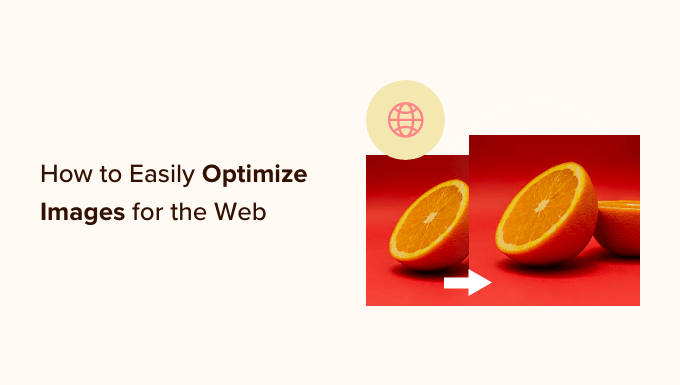
Trattandosi di una guida completa sull’ottimizzazione delle immagini per il web, abbiamo creato un indice facile da seguire:
- What Is Image Optimization?
- What Are the Benefits of Image Optimization?
- How to Save and Optimize Images for Web Performance
- Best Image Optimization Tools and Programs
- Best Image Optimization Plugins for WordPress
- Final Thoughts and Best Practices for Image Optimization
- Expert Guides on Improving WordPress Performance
1. Che cos’è l’ottimizzazione delle immagini?
L’ottimizzazione delle immagini è il processo di salvataggio e consegna delle immagini nella dimensione di file più piccola possibile, senza ridurre la qualità complessiva dell’immagine.
Anche se il processo sembra complesso, in realtà al giorno d’oggi è piuttosto semplice. È possibile utilizzare uno dei numerosi plugin e strumenti per l’ottimizzazione delle immagini per comprimere automaticamente le immagini fino all’80% senza alcuna perdita visibile di qualità.
Ecco un esempio di immagine ottimizzata e non ottimizzata:
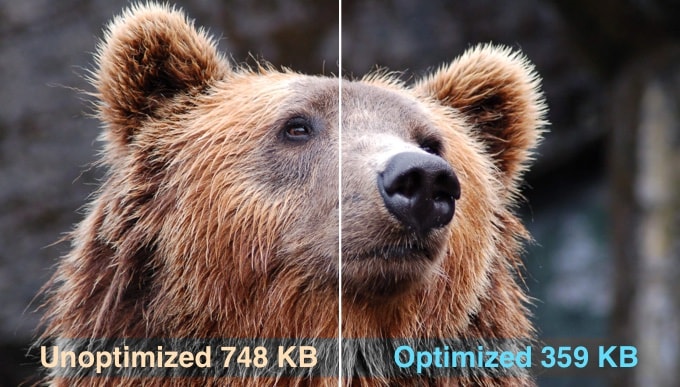
Come si può vedere, se ottimizzata correttamente, la stessa immagine può essere fino all’80% più piccola dell’originale senza alcuna perdita di qualità. In questo esempio, l’immagine è più piccola del 52%.
Come funziona l’ottimizzazione delle immagini?
In termini semplici, l’ottimizzazione delle immagini funziona utilizzando la tecnologia di compressione.
La compressione può essere “lossy” o “lossless”.
La compressione senza perdita riduce la dimensione complessiva del file senza alcuna perdita di qualità dell’immagine. Con la compressione lossy, la perdita di qualità può essere minima, ma idealmente non sarà percepita dai visitatori.
Cosa significa ottimizzare le immagini?
Potreste aver ricevuto una raccomandazione per l’ottimizzazione delle immagini dal supporto del vostro hosting WordPress o da uno strumento di test della velocità e vi siete chiesti cosa dovete fare.
È necessario ridurre le dimensioni dei file delle immagini ottimizzandole per il Web. Vi mostreremo come farlo passo dopo passo.
2. Quali sono i vantaggi dell’ottimizzazione delle immagini?
I vantaggi dell’ottimizzazione delle immagini sono molteplici, ma ecco i principali da conoscere:
- Velocità del sito web più elevata
- Miglioramento delle classifiche SEO
- Un tasso di conversione complessivo più elevato per vendite e contatti
- Meno spazio di archiviazione e larghezza di banda (che può ridurre i costi di hosting e CDN)
- Backup del sito web più veloci (che possono ridurre il costo dello storage di backup)
Le immagini sono il secondo elemento più pesante di una pagina web dopo i video. Secondo l’archivio HTTP, le immagini costituiscono il 42% del peso totale di una pagina web media.
Poiché sappiamo che i siti web veloci si posizionano meglio nei motori di ricerca (SEO) e hanno conversioni migliori, l’ottimizzazione delle immagini è qualcosa che ogni sito web aziendale deve fare se vuole avere successo online.
Ora vi starete chiedendo quanta differenza possa fare l’ottimizzazione delle immagini.
Secondo uno studio di Strangeloop, un ritardo di un secondo nel tempo di caricamento del sito web può costare il 7% delle vendite, l’11% di pageviews in meno e una diminuzione del 16% della soddisfazione dei clienti.
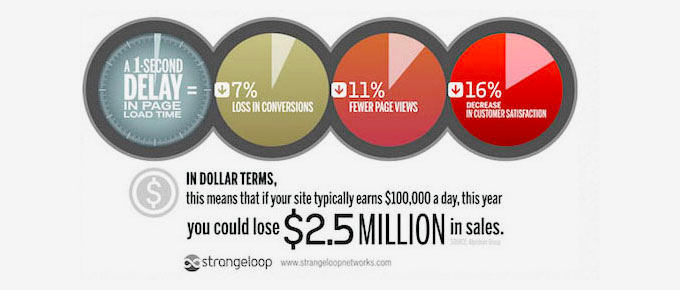
Se questi non sono motivi sufficienti per velocizzare il vostro sito web, sappiate che anche i motori di ricerca come Google riservano un trattamento SEO preferenziale ai siti web che si caricano più velocemente.
Ciò significa che, ottimizzando le immagini per il web, è possibile migliorare la velocità del sito e aumentare le classifiche SEO di WordPress.
Video tutorial
Se preferite le istruzioni scritte, continuate a leggere.
3. Come salvare e ottimizzare le immagini per le prestazioni sul Web
La chiave del successo dell’ottimizzazione delle immagini per le prestazioni del Web è trovare il perfetto equilibrio tra la dimensione minima del file e una qualità accettabile dell’immagine.
I tre elementi che giocano un ruolo fondamentale nell’ottimizzazione delle immagini sono:
- Formato del file immagine (JPEG vs. PNG vs. GIF)
- Compressione (maggiore compressione = minore dimensione del file)
- Dimensioni dell’immagine (altezza e larghezza)
Scegliendo la giusta combinazione di questi tre elementi, è possibile ridurre le dimensioni delle immagini fino all’80%.
Analizziamo ciascuno di essi in modo più dettagliato.
1. Formato del file immagine
Per la maggior parte dei proprietari di siti web, gli unici tre formati di file immagine veramente importanti sono JPEG, PNG e GIF. La scelta del tipo di file giusto svolge un ruolo importante nell’ottimizzazione delle immagini.
Per semplificare le cose, si consiglia di usare i JPEG per le foto o le immagini con molti colori, i PNG per le immagini semplici o trasparenti e le GIF solo per le immagini animate.
Per coloro che non conoscono la differenza tra i vari tipi di file, il formato immagine PNG non è compresso, il che significa che è un’immagine di qualità superiore. Lo svantaggio è che le dimensioni dei file sono molto più grandi.
D’altra parte, JPEG è un formato di file compresso che riduce leggermente la qualità dell’immagine per fornire un file di dimensioni significativamente inferiori.
Mentre la GIF utilizza solo 256 colori e una compressione senza perdite, il che la rende la scelta migliore per le immagini animate.
Su WPBeginner, utilizziamo tutti e tre i formati di immagine in base al tipo di immagine.
2. La compressione
Il punto successivo è la compressione delle immagini, che svolge un ruolo fondamentale nell’ottimizzazione delle immagini.
Esistono diversi tipi e livelli di compressione delle immagini. Le impostazioni per ciascuno di essi variano a seconda dello strumento di compressione delle immagini.
La maggior parte degli strumenti di modifica delle immagini, come Adobe Photoshop, ON1 Photo, GIMP, Affinity Photo e altri, hanno funzioni di compressione delle immagini integrate.
È anche possibile salvare le immagini normalmente e poi utilizzare uno strumento web come TinyPNG o JPEGmini per facilitare la compressione delle immagini.
Sebbene richiedano un certo sforzo manuale, questi due metodi consentono di comprimere le immagini prima di caricarle su WordPress, ed è quello che facciamo su WPBeginner.
Esistono anche alcuni popolari plugin per WordPress, come Optimole e EWWW Image Optimizer, in grado di comprimere automaticamente le immagini al primo caricamento. Questo è comodo e molti principianti e persino grandi aziende preferiscono usare questi plugin per l’ottimizzazione delle immagini.
Più avanti nell’articolo parleremo dell’utilizzo dei plugin di WordPress.
3. Dimensioni dell’immagine
Normalmente, quando si importa una foto dal telefono o da una fotocamera digitale, questa ha una risoluzione molto alta e grandi dimensioni del file (altezza e larghezza).
In genere, queste foto hanno una risoluzione di 300 DPI e dimensioni a partire da 2000 pixel. Mentre le foto di alta qualità sono adatte alla stampa o al desktop publishing, le loro grandi dimensioni le rendono inadatte ai siti web.
Ridurre le dimensioni dell’immagine a qualcosa di più ragionevole può ridurre significativamente le dimensioni del file. È possibile ridimensionare le immagini utilizzando un software di editing di immagini sul computer.
Ad esempio, abbiamo ottimizzato una foto con una risoluzione di 300 DPI e dimensioni di 4900×3200 pixel. La dimensione del file originale era di 1,8 MB.
Abbiamo scelto il formato JPEG per una maggiore compressione e abbiamo modificato le dimensioni in 1200×795 pixel. La dimensione del file è stata ridotta a soli 103 KB. È il 94% in meno rispetto alle dimensioni del file originale.
Ora che conoscete i tre fattori importanti per l’ottimizzazione delle immagini, diamo un’occhiata ai vari strumenti di ottimizzazione delle immagini per i proprietari di siti web.
4. I migliori strumenti e programmi per l’ottimizzazione delle immagini
Come abbiamo detto in precedenza, la maggior parte dei software di editing delle immagini è dotata di impostazioni di ottimizzazione e compressione delle immagini.
Al di fuori del software di editing delle immagini, esistono anche diversi potenti strumenti gratuiti per l’ottimizzazione delle immagini che possono essere utilizzati per ottimizzare le immagini per il web (con pochi clic).
Vi consigliamo di utilizzare questi strumenti per ottimizzare le immagini prima di caricarle su WordPress, soprattutto se siete dei perfezionisti.
Questo metodo consente di risparmiare spazio su disco sul proprio account di hosting WordPress e garantisce immagini più veloci e di qualità migliore, poiché ogni immagine viene esaminata manualmente.
Adobe Photoshop
Adobe Photoshop è un’applicazione premium per l’editing di immagini che consente di esportare immagini di dimensioni ridotte per il web.
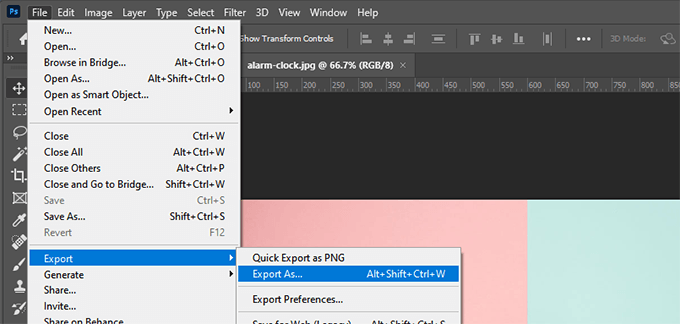
Utilizzando la finestra di dialogo di esportazione, è possibile scegliere il formato di file immagine (JPG, PNG, GIF) che offre le dimensioni più ridotte.
È inoltre possibile ridurre la qualità dell’immagine, i colori e altre opzioni per ridurre ulteriormente le dimensioni del file.
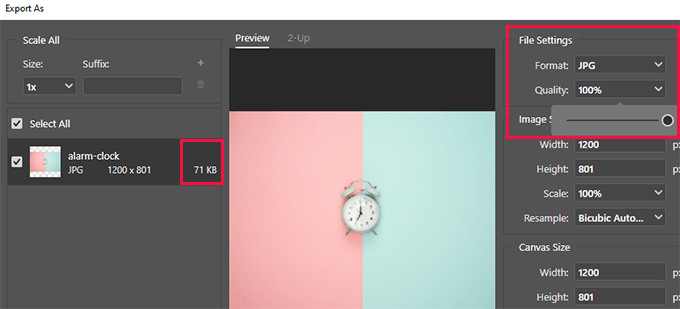
GIMP
GIMP è un’alternativa gratuita e open-source ad Adobe Photoshop. Può essere utilizzato per ottimizzare le immagini per il web. Lo svantaggio è che non è facile da usare come altre soluzioni di questo elenco.
Per prima cosa, è necessario aprire l’immagine in GIMP e selezionare l’opzione File ” Esporta come…. Verrà visualizzata la finestra di dialogo Esporta immagine, dove è possibile assegnare un nuovo nome al file. Successivamente, è necessario fare clic sul pulsante ‘Esporta’.
A questo punto vengono visualizzate le opzioni di esportazione delle immagini. Per i file JPEG, è possibile utilizzare il cursore ‘Qualità’ per selezionare il livello di compressione e ridurre le dimensioni del file.
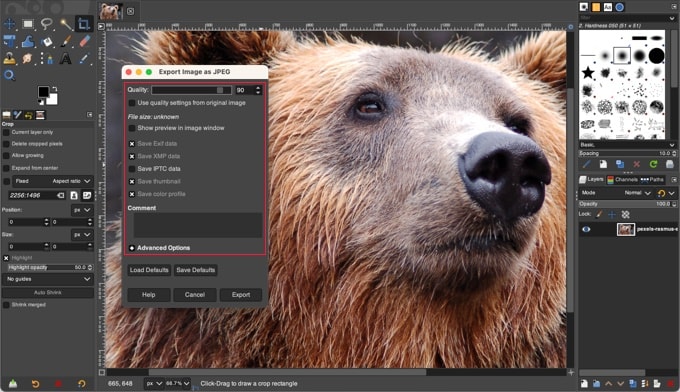
Infine, fare clic sul pulsante ‘Esporta’ per salvare il file immagine ottimizzato.
TinyPNG
TinyPNG è un’applicazione web gratuita che utilizza una tecnica di compressione lossy intelligente per ridurre le dimensioni dei file PNG e JPEG. Tutto ciò che dovete fare è andare sul suo sito web e caricare le vostre immagini con un semplice drag and drop.
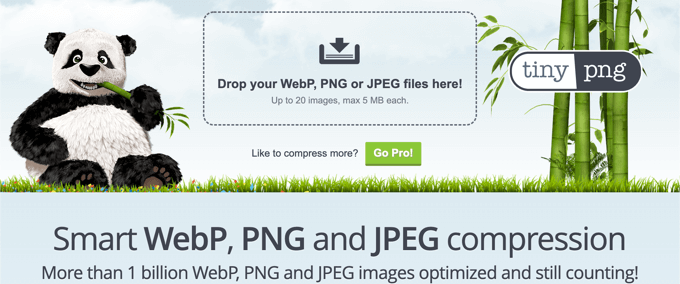
Comprimeranno l’immagine e vi forniranno un link per il download.
Hanno anche un’estensione per Adobe Photoshop, che è quello che usiamo come parte del nostro processo di editing delle immagini, perché consente di accedere a TinyPNG dall’interno di Photoshop.
Per gli sviluppatori, hanno un’API per convertire automaticamente le immagini. Inoltre, per i principianti, è disponibile un plugin per WordPress che lo farà per voi. Ne parleremo più avanti.
JPEGmini
JPEGmini utilizza una tecnologia di compressione senza perdita di dati che riduce significativamente le dimensioni delle immagini senza alterarne la qualità percepita. È inoltre possibile confrontare la qualità dell’immagine originale e di quella compressa.
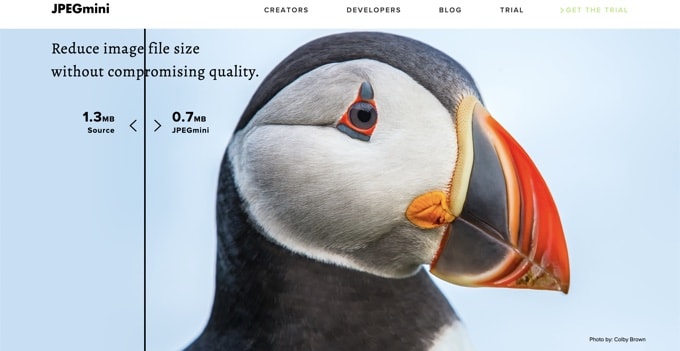
È possibile utilizzare la versione web gratuitamente o acquistare il programma per il proprio computer. Esiste anche un’API a pagamento per automatizzare il processo per il vostro server.
ImmagineOptim
ImageOptim è un’utility per Mac che consente di comprimere le immagini senza perdere qualità, trovando i migliori parametri di compressione e rimuovendo i profili di colore non necessari.
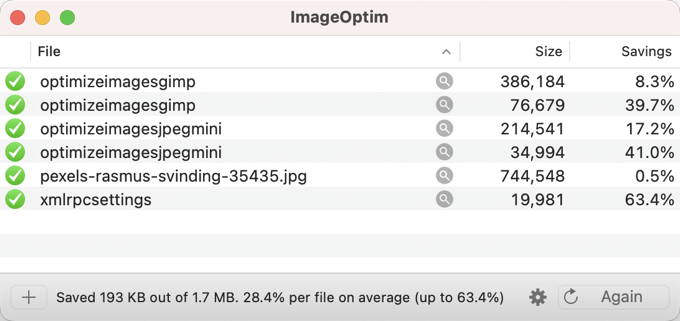
Un’alternativa a Windows è Trimage.
5. I migliori plugin per l’ottimizzazione delle immagini per WordPress
Riteniamo che il modo migliore per ottimizzare le immagini sia farlo prima di caricarle su WordPress. Tuttavia, se gestite un sito con più autori o avete bisogno di una soluzione automatica, potete provare un plugin per la compressione delle immagini di WordPress.
Ecco il nostro elenco dei migliori plugin per la compressione delle immagini di WordPress:
- Optimole, un popolare plugin realizzato dal team di ThemeIsle
- Ottimizzatore di immagini EWWW
- Compressione di immagini JPEG, PNG e WebP, un plugin del team di TinyPNG citato in precedenza.
- Imagify, un plugin del famoso team di WP Rocket
- Ottimizzatore di immagini ShortPixel
- Smush
- reSmush.it
- Envira Gallery è un plugin per gallerie di WordPress con compressione delle immagini integrata.
Questi plugin per l’ottimizzazione delle immagini di WordPress vi aiuteranno a velocizzare il vostro sito web.
6. Riflessioni finali e buone pratiche per l’ottimizzazione delle immagini
Se non salvate le immagini ottimizzate per il web, dovete iniziare a farlo subito. Farà un’enorme differenza nella velocità del vostro sito e i vostri utenti vi ringrazieranno per questo.
Per non parlare del fatto che i siti web più veloci sono ottimi per il SEO e probabilmente vedrete un aumento delle posizioni nei motori di ricerca.
Al di fuori dell’ottimizzazione delle immagini, le due cose che vi aiuteranno in modo significativo a velocizzare il vostro sito web sono l’utilizzo di un plugin di caching per WordPress e l’utilizzo di un CDN per WordPress.
In alternativa, potete utilizzare una società di hosting WordPress gestita, perché spesso offre sia la cache che il CDN come parte della piattaforma.
Guide di esperti su come migliorare le prestazioni di WordPress
Speriamo che questo articolo vi abbia aiutato a capire come ottimizzare le immagini in WordPress. Potreste anche voler consultare altri articoli relativi al miglioramento delle prestazioni di WordPress:
- La guida definitiva per aumentare la velocità e le prestazioni di WordPress
- Come velocizzare le prestazioni di WooCommerce
- Come scaricare i media di WordPress per migliorare la velocità del sito web
- I migliori plugin per la cache di WordPress per velocizzare il vostro sito web
- Come ottimizzare Core Web Vitals per WordPress (Guida definitiva)
- Come ridurre il tempo al primo byte (TTFB) in WordPress – Suggerimenti degli esperti
- Come utilizzare il plugin GTmetrix per migliorare le prestazioni del sito WordPress
- L’hosting WordPress più veloce (test delle prestazioni)
- Metriche importanti da misurare sul proprio sito WordPress
- Come eseguire correttamente un test di velocità del sito web
- Come sottoporre a stress test un sito web WordPress
Se questo articolo vi è piaciuto, iscrivetevi al nostro canale YouTube per le esercitazioni video su WordPress. Potete trovarci anche su Twitter e Facebook.





Diane Talbotier
Hi, does resizing mean changing the size of the images as they are shown on the website, or resizing the size of the file , please?
And how do I know what is the optimal size?
WPBeginner Support
It would depend on what you mean, for compression in this guide, it is the size for the file. You can also reduce the width and height of an image if it is too large. Your specific theme would determine the specific image size you want to use.
Admin
Terri
You mentioned in your optimise example that your original photo was 300dpi, then you optimised it to a smaller file size. But you did not say what the target dpi was. Is it 72 for web? Or higher? Thanks for the informative article.
WPBeginner Support
That would depend on your personal preference and how large you are wanting/needing the images to be.
Admin
Romel
thanks a lot it cleared a lot of doubts.
WPBeginner Support
Glad our article was helpful
Admin
Odenyi Emmanuel Chidera
What I like most about wpbeginner is how they will give you information on what to implement on your own site but also tell you what they are using on their own site. It really helps me decide faster. Learning from a master is always easier. Thanks.
WPBeginner Support
You’re welcome, glad you like our content
Admin
Luz Manalo-Cruz
I’ve compressed images via TinyPNG and tried to replace the heavier images on my site with these (ie. I deleted the heavy photos and uploaded the compressed ones). However the media library is still uploading the old heavier images. Does that mean that I can’t replace the old images already uploaded? Will it only upload the compressed images that have not been uploaded at all?
WPBeginner Support
If you are replacing the heavier images, you would want to ensure you don’t have caching on your site that is showing the old image and when you upload the new image that you are uploading the correct image.
Admin
Giovanna
Thanks for the informative article, Syed.
Moving forward I am going to make sure to always use optimized images. Do you recommend I go back to already published posts and replace my images with optimized ones?
WPBeginner Support
If possible we would recommend updating your older images, the plugins we recommended should handle that for you
Admin
Percy Young
Thank you for your post. many nice tools. I wonder if theres any thing to be done to rezize images that have been previously uploaded, and how to delete images the worpress is not using any more.
WPBeginner Support
If you need to generate new images you could follow our guide here:
https://www.wpbeginner.com/plugins/regenerate-thumbnails-new-image-sizes-wordpress/
For removing the extra images there are media cleanup plugins that you are able to use
Admin
WPBeginner Support
Glad you’ll use our recommendations
Admin
Dr Amandeep Sandhu
Thanks for sharing such ideas….!
WPBeginner Support
You’re welcome, thanks for reading our articles
Admin
İbrahim BOZKURT
I’m a WordPress developer. I am writing from Turkey.
Very difficult to find quality WordPress resources.
I discovered you. I didn’t know English but learned English. Thanks to you everything.
WPBeginner Support
Thank you for reading our articles and congratulations on learning a new language
Admin
Felipe Adan Lerma
Hi, it seems maybe WordPress has incorporated some of this into its current image upload process, at least in the Premium bracket?
I ask cause I now get the option to choose the actual size or something larger or smaller?
Or is that process not an optimization / reduction in size of the image?
Thanks so much! Very important useful topic.
Adan
WPBeginner Support
It sounds like you may be talking about WordPress.com and they have custom plugins setup for sites on their service
Admin
Felipe Adan Lerma
Ahhh, yes, I forget the two WP’s differ, sorry. I’m still trying to figure out how to work where I am w/WP & it’s definitely via their .com sites. Thank so much then, WP – Adan
WPBeginner Support
No worries, should it help we have our article listing the differences here:
https://www.wpbeginner.com/beginners-guide/self-hosted-wordpress-org-vs-free-wordpress-com-infograph/
Anna
Very helpful info!! I was just researching how to do this when your email came through! Saved em time and effort and had just the advice I was looking for.
WPBeginner Support
Glad our guide and newsletter could be helpful
Admin
Lindsay
When saving on photoshop what width do you suggest for optimum web performance?
My theme is saving 1600×1050 for optimum header but what should I do for the body images. Theme designer doesn’t have a recommendation.
WPBeginner Support
If you’re going through the other steps in this article then the image size would be what would fit your content’s dimensions best so WordPress wouldn’t need to resize the image.
Admin
edccde
Please update that youtube video.First of all Jpegmini isn’t a web app and it is a software which i have to install in my pc.
WPBeginner Support
Thank you for letting us know about the video, we’ll certainly look into updating the video
Admin
Jackie
Is there way to compress images already uploaded to wordpress? Or do I need to compress all my images and then reupload into WP? THanks in advance for the advices.
Irina
Hi,
Need an advice: I need to upload Low res and Hi-res images (1200pix at 300dpi) so my customers can download them. I have no questions about LR image optimization. How can I save hi-res images? The size is up to 2 MB. I have hundreds of thousands of images…
Ratan Kumar
This post is awesome and really add value to my site. However, I recently tried to save images from flipkart but it saved in very low pixel format. Wondering if you can help me to figure out on how to do that.
Ray
I already bulk uploaded 1500 product images that were connected to image urls I found on the internet.
Now that I have those 1500 images already in my Media Library, how can I go back and resize and compress them?
Also, I’m confused about whether resizing means changing the size of the images as they are shown on the website, or resizing the size of the file.
Thanks!
Sara Lewis
what about the plugin ewww image optimizer?
WPBeginner Support
Hey Sara,
Yes its a good alternative. However, for better results we would still recommend optimizing images in your image editing program before uploading to WordPress.
Admin
Donna
I will be travelling to a place where internet connectivity is limited and expensive. So, I want to reduce the file size of my photos before I go online to upload them to my blog. Can someone please recommend for me what resolution and dpi would be good to use? The app I am planning to use asks for three measurements:
resolution – from 200 to 2048
DPI – from 72×72 to 300×300
jpeg quality (compression level) – from 0.00 to 1.00
Carrie
In the video she changes her pic. I understand the screen in PS. But you have not explained what should the width and height be in pixels for WP the limit is 2mb. What would be a good standard for sliders, etc for a wp site?
Carrie
Sorry for being the dunce in the corner, but could someone please clarify one thing? I installed the WP Smush it plugin and have been slowly working through all the photos I’ve uploaded to my site for the last 2 years. I’m doing 50 at a time, the free limit. However, now that I have the plugin, for future photo uploads, does having it mean I don’t have to use any other program to resize my photos before uploading them to my WP site? If I have an 8 MB photo and upload it to my site, the plugin does everything for me? I just want to confirm that the original photo is not still uploaded and saved to my host server, SiteGround. My site is wicked slow, I’ve run tons of diagnostics, and I still can’t figure out why except that everything points to my photos. Thanks!
Tony Squibb
Hi Carrie, I’m defo not an expert in any way but I do have experience with WP Smush it and yes, future uploads should be auto ‘smushed’. There is a little notification in the media gallery as you do so.
To check the causes of your slow site you can use GTmetrix and then open the waterfall page where it will show the times of the individual pages items loading. Once you know what is the problem you can then address it.
I hope that helps from one ‘dunce’ to another
Carrie
Hi Tony,
Thanks for weighing in! Unfortunately I uninstalled WP Smush and tried EWWW Image Optimizer along with the Thumbnail Regerate plugin (based on another bloggers suggestion) and royally messed up the photos on my site. I’m a newb with regards to how to manage my files through the FTP on my web host, so I ended up deleting a bunch of images (as in hundreds) and re-uploading them after resizing them manually in an image program. Turns out that too was a bad idea. Now I have a bunch of error messages when I render my site in my Google Console because when Google crawls my site, those files are now gone or moved. AGH! I’m on the verge of simply paying someone to revamp my site or quitting altogether. But I really appreciate that you took the time to leave a helpful comment.
Happy New Year! May 2017 be better than 2016.
Jeff
hi
Best Image Optimization Plugins for WordPress Site Which is?
Gagan
I was thinking what if i upload my Images to Google Blogger and use them on my wordpress Site by “Insert From URL” option?
Any suggestion if this is a Good Idea or no?
Thanks in advance
Zimbrul
I came back here as I’m looking for plugins that upload a large image as a optimised image straight to WordPress. I’m sure I’ve seen this somewhere here at WP Beginner but I cannot find it.
WPBeginner Support
Please take a look at Optimizing images with WP Smush pros, cons, and alternatives.
Admin
Jack
Photoshop is definitely the best one, for online services, kraken.io and resizeimage.net are good alternatives to tinypng.
tanveer
is xnview a good option for compressing images?
WPBeginner Support
We haven’t tried it.
Admin
Larry Aldrich
Someone mentioned RIOT in an earlier comment. It is my go-to app for minimizing images BEFORE you upload them. The compression rate is close to phenomenal. Sorry MAC users, but it’s only available for Windows.
Martin
Hello WPBeginner,
I would be very interested in the Windows version of Trimage you have apparently seen.
On the Trimage homepage you just see a link asking for help with the windows port…
Greg
I have got used to using Fireworks even though I have CS3
Zimbrul
Me too. I use CSS4 and still go to Fireworks for image optimisation.
Marianne P.
I just checked out the Trimage site and did not see the Windows version – just various *nix versions. Please point me in the right direction. Thanks so much – really great article!
Corinna
I was wondering if there was any way of reducing the size of the images already uploaded to a site? I have changed the way I upload them so in future all my images will be smaller. But I thought maybe it would be useful to change the size of those already uploaded.
Julie Anglesey
I would also like to know how to reduce the size of images already uploaded.
Zimbrul
It’s (or was) Smush-It.
Samiullah Khan
Search the web too much to find good solution to optimize images; but most of them most of them doesn’t let’s see tools mentioned in this post work or not
Graham
The article defines PNG as an uncompressed file format, but as far as I know, standard PNGs use lossless compression.
And I think it would be helpful to mention why you might choose one format over another for continuous tone images (eg. a photo) vs. limited palette images (eg. a logo).
Rob Dewing
Why no mention of Photoshop Elements, the cut down home use version of Photoshop? It does 90+% of the things full phat Photoshop will do, including ‘save for web’ image compression, all for less than $100.
Ines
Would you recommend to use Flickr to upload your images and then copy the HTML code to your wordpress site? What would you suggest for travel blogs that contain lots of pictures? Thanks.
WPBeginner Support
You can add flickr photos in WordPress by simply pasting the photo URL in a post. Normally we would not recommend it, because people will be viewing and finding your photos on Flickr and may never even get a chance to visit your website. However, if you feel that building a community around your photos on flickr is more useful for you, then sure go ahead.
Admin
Benjamin
You could add kraken.io to your list. It does the same thing as Jpegmini but also works with PNG images.
Aurel
I am using RIOT, which is free, very fast and exelent program.
Debra Torres
I’ve been using the Yahoo Smush it tool at: http://www.smushit.com/ysmush.it/
Would you recommend this one? Or are the others you mentioned better?
WPBeginner Support
Smushit is a great tool too. But try other tools we mentioned and compare the results.
Admin
James DiGioia
There is WordPress plugin for Smush.it:
http://wordpress.org/plugins/wp-smushit/
This makes it easier to compress images using Smush.it without having to prep them beforehand.
Youri van Dijk
I was about to mention that plugin as well. I generally do save my images optimized myself, but for clients that are not very familiar with these tools installing the plugin is a huge benefit.
John Mauldin
Your article is VERY timely. Just encountered the need to reduce hundreds of photos for a kitchen and bath showroom. Bought JPEGmini since I could only do 20 photos a day in the free version but $19.99 is nothing for the ability to drag and drop entire folders into the program and have it zip them in seconds/minutes. Thanks so much for the help!
Haseeb
Isn’t there any automated way of doing this on wordpress? How about ‘WP Smush.it’ ?
Editorial Staff
You can automate the process with some tools that we mentioned or using this plugin:
http://wordpress.org/plugins/ewww-image-optimizer-cloud/
But why create more server load when this can be resolved by educating the user.
Admin
Marlene
Great article, however I was under the impression that any images with text on them should be saved as PNG files for best sharpness….?
Editorial Staff
PNG will definitely have a higher quality, but most folks won’t be able to tell the difference unless you put them side-by-side. If you can speed up your site with a non-noticeable difference, then why not
Admin
Adam W. Warner
Great article, and an important subject many WordPress admins miss.
[Link Removed]
Lynn
Lightroom has a number of presets for exporting to Facebook and Web – do those compress the photo files sufficiently or should I still turn to Photoshop?
Editorial Staff
Not sure about lightroom and how it exports image. You can run a side-by-side test.
Admin
Graham
Lightroom will do pretty much the same job as Photoshop when exporting photos to JPEGs.
Bill Wells
Lightroom is the go-to for photographers; it allows you to optimise your photos in batches and then will export the batch to your preferred pixel size and compression in a number of formats, including jpeg. It also automatically adds your copyright message to the batch if you want.
I don’t know about batch-processing in Photoshop but I use it for major image manipulation only.
I guess if you’re doing graphics or heavy manipulation, use Photoshop but if you’re using lots of photos and just want them to look their best, use Lightroom.
Scott Wyden Kivowitz
I’m a big advocate for many of the products you mentioned. Now I get to add this link to my resources for whenever customers ask me this exact question. Thanks Syed.
Editorial Staff
You’re very welcome Scott.
Admin
Dave Kulas
If you are taking the pictures yourself for your website …. set your camera to take a picture at 800 x 600 and at less resolution. Some camera have a Good – Better – Best resolution setting … use the “GOOD” setting. . You should get an image that will load quickly.
If you already have some images … take a look at for FREE … http://www.getpaint.net ….. I have been using it for years. I take the HUGE photos given to me by clients … then RE-SIZE them to 800 x 600. Then I use the built in compression tool to compress the image.
Steven Alig
I would not recommend taking low resolution photos.
You will want to take your original photos at higher resolutions just in case you want to use them for something else. Plus if you take photos at a higher resolution, you will have the ability to crop in on an area if desired.
If the photos are a lower resolution, you will not have that option and will be stuck with what you have taken as the original.
Mark Pridham
I have to agree with Steven on this. I highly recommend taking high resolution images in your camera. You then have a large file that you can work with, It very easy to reduce file size from a hi-res image, but impossible to go the other way. By taking hi-res images, you also have the option of using them for print work if the need arises, Generally, I end up with the large, raw image, a cropped and retouched print image, and a smaller image for web-based work.
Michael Maye
I would agree too about taking full high resolution photos. Then resize down and compress for uploading to your website. You will always have the original high res photo for other uses.
Zimbrul
I usually use Fireworks and then Tiny PNG if required.
Editorial Staff
Yup that’s a good combination
Admin
Geoffrey Gordon
Great article Syed.
However I really think that fireworks is the king when it comes to optimising images for the web and its a whole lot cheaper than Photoshop.
Editorial Staff
Thanks Geoffrey. Yup I know Photoshop is expensive which is why I mentioned other free tools as well. GIMP and Fireworks both has this functionality.
Admin
paul
So I’ll just follow the options as seen on the image in this article’s Photoshop section and it’s all good?
Editorial Staff
Yup, if you do that, then you will have probably one of the best performance results. However depending on an image, some might not look as good, so in those cases we try the Very High. Do it on case by case basis, but most images would be fine.
Admin
Andrew Brown
You discuss using Photoshop, which is way beyond most bloggers needs or price – why do you not refer to Lightroom, which also has an excellent image export option, including an option to restrict the max file size, as well as save by dimension or using a set dpi.
Once some one knows the comp screens work at 72dpi, the rest becomes much easier, and it becomes amazing as to how easy it is to have a web template amongst the export options without needing any real in depth knowledge of what needs to be done.
Editorial Staff
Andrew,
Yes we understand that Photoshop is expensive which is why we mentioned several other free options. Just updated the article now to add a link to GIMP right below photoshop.
As for Lightroom, didn’t mention it because we don’t use it. Same reason why Fireworks was left out.
Admin